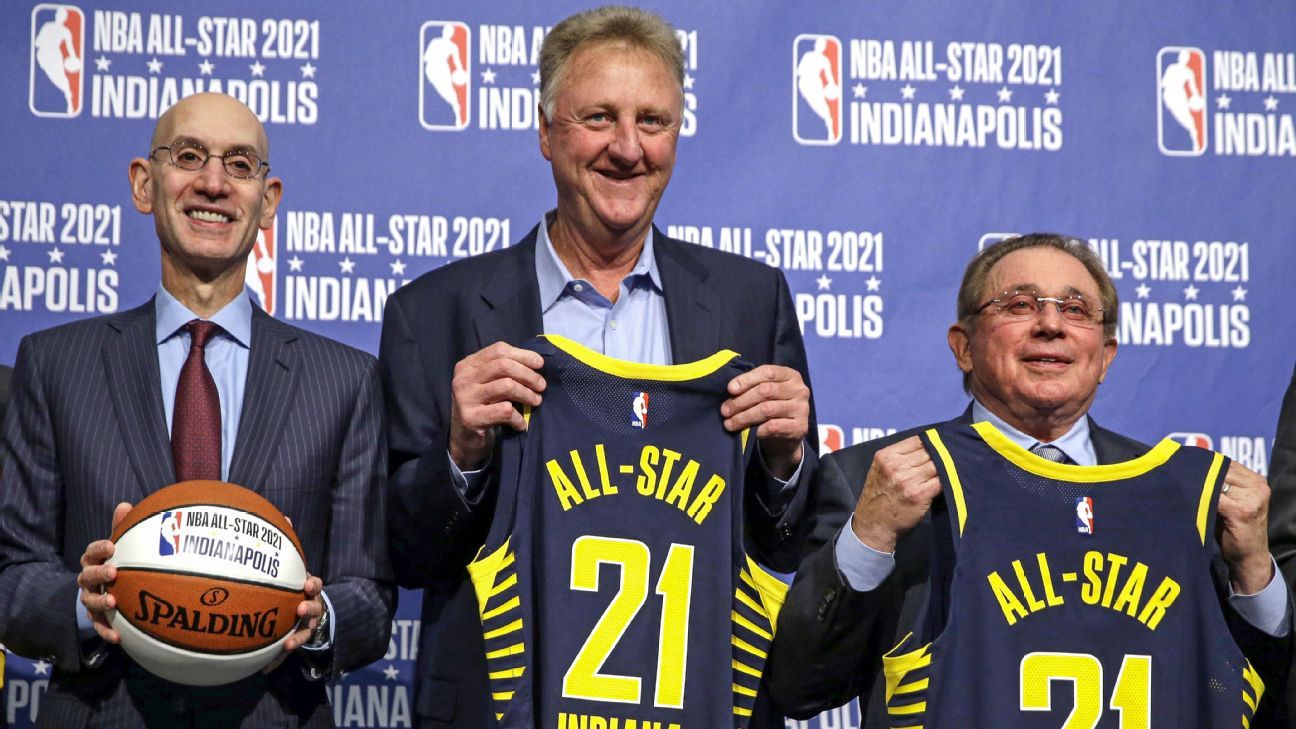Over the past three months, the NBA’s league office has exhausted itself in stitching together a comprehensive plan to conclude the 2019-20 season. In the front offices of the league’s 30 franchises, though, a more complicated problem has clouded the horizon:
What will the 2020-21 season look like?
Even as the NBA establishes its bubble in Orlando, Florida, several dates are rushing toward it. Owners have established Dec. 1 as the target to start next season’s games.
But the date of more immediate concern to teams is Oct. 18 — the proposed start of free agency. By then, all financial matters for this season and projections for next will need to be known.
What is known around league circles at present is that the league must clear three massive hurdles to begin next season:
-
The first is currently being navigated: how to safely play in a world with COVID-19.
-
The next two are equally complex: brokering a deal between owners and players on how to financially operate,
-
and how 30 teams facing different market conditions will share money to keep the entire league afloat.
“The truth is, things are changing so fast that, when it comes to next season, the best we can do is put a stake in the ground and make a guess,” an Eastern Conference team president said. “The reality is nobody is probably going to operate in the black next season.
“The only question is how much each of us are going to lose.”
When the 2019-20 season was halted by the coronavirus pandemic, approximately 75% of the regular season had been played. Though the lack of playoff ticket revenue is leading to substantial losses now, teams had already collected billions in gate, arena and sponsorship revenue. At the moment, it is unclear if next season’s games will be in home arenas, let alone have fans in attendance, making revenue projections impossible.
In early May, NBA commissioner Adam Silver shared with players on a conference call that about 40% of the league’s once-projected $8.4 billion in revenue came from arenas. With players expected to have guaranteed contracts of around $4 billion next season and a collective bargaining agreement that assures a 50-50 split of basketball revenue, outlining the problem was clear.
“This CBA was not built for an extended pandemic,” Silver told the players. “There’s not a mechanism in it that works to properly accept a [salary] cap when you’ve got so much uncertainty; when we’d be going [into] next season saying, ‘Well, our revenue could be $10 billion or it could be $6 billion. Or less.'”
An ugly version of this process played out with Major League Baseball in recent months. Its players and owners struggled to rework agreements for once-assured payments, straining league and union relationships that could still result in a legal battle despite MLB’s scheduled restart of the 2020 season later this month.
As seen during the negotiations to restart the season at Disney World, the relationship between the NBA and the National Basketball Players Association has never been stronger. Silver and the NBPA leadership — executive director Michele Roberts and president Chris Paul — together spearheaded a return to play that both sides have largely endorsed.
To even get to this tenuous point, there was a crucial agreement in April on how to balance the books for the remainder of the 2019-20 season, providing further evidence that the two sides should be able to come up with an amenable deal.
The NBA and players have agreed to a September deadline for what modifications will need to be made to the labor agreement.
There have been no formal negotiations as yet, but teams, the union and agents are making preparations for these vital talks. Various stakeholders who spoke to ESPN described the basics of a plan that could create a consensus in the fall.
The starting point is the inverse of the “cap spike” that hit the league in 2016, the influx of new television that caused the salary cap to balloon and famously enabled the Golden State Warriors to sign Kevin Durant.
At the time, the league office hoped to phase in the new revenue over three years by gradually increasing the cap — a process dubbed “smoothing.” To ensure that players still received the 50% split owed, each player would have received a bonus check at the end of the season to balance the books.
The union rejected it, and the league didn’t push the issue. As a result, the cap jumped by $24 million on July 1, 2016.
Now in 2020, the loss of ticket and arena revenue could cause a dramatic drop in the salary cap. Once again, the smoothing idea is back. And this time, it could have a much more receptive audience.
Instead of a steep drop, the concept would be to keep the cap artificially high for the 2020-21 season — potentially around the current $109 million — and achieve the needed 50-50 split by every player taking an equal percentage pay cut.
Currently, 10% of players’ salaries are held in escrow during the season to balance any discrepancies between the projected and actual revenue for the year. In recent seasons, players have recouped the entire 10% escrow and even got additional payout as league revenue climbed. In 2017, that payout was $355,000 per player.
One option, according to sources, would be to increase that escrow amount, perhaps to 20%, for one season. This would allow for a cash reserve at the end of the season when determining the league’s financial equilibrium.
Artificially inflating the cap would have benefits for both sides. For players, it would be a way to avoid penalizing those entering free agency after this season.
For example, free agent-to-be Anthony Davis could sign a max contract starting at $32.7 million, even if some of that is ultimately lost through escrow next season. With a revenue-accurate salary cap, Davis would sign a deal that could see him lose tens of millions in guaranteed money over the next five years if league revenues rebound on the other side of the virus as hoped.
For teams, an inflated cap would allow the league to remain somewhere near its current financial structure. A sudden drop in the cap could see a lot of teams plunged into the tax who weren’t projecting to be in it. It also would allow teams with large payrolls to avoid unexpectedly massive luxury tax bills. On the other hand, those massive luxury tax bills could help boost the league’s smaller markets.
The Warriors and Philadelphia 76ers, for example, both planned for now-outdated salary numbers when building their respective payrolls to over $140 million for next season.
“Don’t think it’s lost on any of us that the Warriors could end up benefiting from the cap spike in 2016 and then cap smoothing if we have it in 2020,” one general manager said.
Another league executive said, “I agree this concept makes the most sense in the uncertain times we have. But if [smoothing] is where it goes, it does penalize teams who have done better long-term planning.
Another option, per sources, would be for whatever player salaries needed to balance the revenue split beyond the traditional 10% held in escrow could be offset in future seasons.
“In one case, the owners want a loan from the players. And in the other case, the players want a loan from the owners,” one prominent agent said. “It will probably end up somewhere in the middle and it will get done after some yelling and posturing.”
Regardless of the particulars, both sides privately agree that it is in everyone’s interest to get a deal done.
The grousing by some as teams around the league judge who might benefit from a gap agreement with the union portends an additional fight that might manifest itself this fall — a battle between owners over revenue sharing.
Typically, the league’s big-market franchises — the Warriors, New York Knicks, Los Angeles Lakers — generate more than $100 million per season in profit and distribute a percentage to smaller-market teams who take in less revenue.
But arenas in New York, Los Angeles, San Francisco and elsewhere could potentially be closed or operating with greatly reduced capacity next season.
“The Lakers and the Knicks may not have any fans, suites or anything,” an Eastern Conference team president said. “The revenue to be shared may not be there. There could be some fighting.”
If no fans are allowed in San Francisco, but markets such as Charlotte, Memphis or Orlando are able to accommodate attendance, traditional revenue sharing becomes distorted.
In a recent meeting with team presidents, sources said deputy commissioner Mark Tatum shared that the NBA’s current plan is to allow local governments to regulate crowds at sporting events. That opens the possibility that revenue could be disproportionately influenced by the policy views of politicians.
“Traditional alliances may not be there because market size may not matter as much as market conditions,” a Western Conference president said. “And those are ever-changing.”
Some big-market teams are highly leveraged. The Warriors have been the highest-revenue team in the league in recent years, but they’ve paid more than $1 billion to construct the Chase Center and have major debt to finance. Tilman Fertitta paid a record $2.2 billion to buy the Houston Rockets in 2017 and his businesses require $250 million a year in debt service costs.
Without income from arenas, teams that were dependable revenue sharers might not be able to contribute to the system. And getting owners to find a common ground could be a challenge for Silver.
Because small- and medium-sized markets lack the same ability to generate massive amounts of cash every season, they typically plan out payroll years in advance in the event of a down year. That necessity would allow some of them to mitigate such a dramatic downturn.
“Well-run teams have rainy-day funds and credit available,” a league executive said.
Whether friction from revenue sharing would delay the season is unknown, but it could affect team spending in free agency — or even motivate some teams to shed salary to manage any losses. Several teams have already had significant layoffs, with more probably coming.
After much chatter before the stoppage of changes in the coaching ranks, several league executives told ESPN that teams might be more likely to hang on to coaching staffs longer than planned to avoid paying out millions to coaches fired in current market conditions.
Other executives have speculated the league could institute another amnesty provision — a team would have the ability to waive a player and remove their salary from the cap while spreading out the remaining contract payment over several years — as a way to help teams with the financial crunch. Others suggest temporary relief from the current rules regarding reaching the salary floor to avoid forcing teams to spend money just to climb over it.
“There’s cash flow,” a team president said. “With TV deals, teams should have over $100 million [each] coming in. We should be able to fund the season.”

